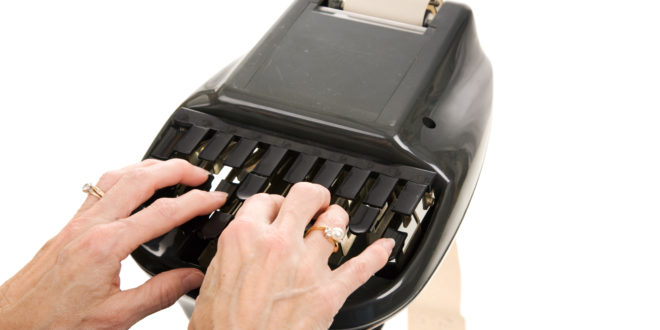
What Is A Stenographer And How Does Stenography Work
Writing fast and writing correctly is an incredible skill in itself. You may have wondered how the person documenting a court case or writing down a media interview manages to note down everything at such a fast pace. That is what stenography is all about. Such people are trained to write in what we call “shorthand” methods. The modern-day stenographer has, however, evolved from the traditional methods and there are now new ways that make writing or typing fast much easier.
Let’s try to understand everything about stenographers and stenography here.
What is a stenographer?
A stenographer is a trained transcriptionist who can record dictation or speech to a written copy. The term stenography comes from the Greek words “stenos” and “graphy.” Stenos means narrow while graphy means writing, so stenography translates to narrow writing which is what shorthand does.
Now visit ExLibro and get a Qualified continuing education for lawyers, lawyers and estate agents, as well as accountants and accounting consultants.
Back in the day, traditional stenographers documented speech into writing by hand. The traditional shorthand method relied on symbols representing specific words, letters, or sounds. Using these symbols instead of writing complete words and sentences made it much easier to note down speech faster.
Modern-day stenographers or transcriptionists do not transcribe by hand though. There are numerous shorthand typing machines today, which are called stenotype machines. These are typing machines with specially designed keyboards that allow a stenographer to write at a rate of nearly 300 words a minute. That is almost double the speed of what a person could type on a regular keyboard.
Understanding the stenotype machine
The stenotype machine (also called the stenograph), used by court reporters and transcriptionists, has a special keyboard with only 22 keys. The modern stenograph has two rows of keys on each side, which represent consonants, and 4 keys at the center, in front, with the vowels A, O, E and U. There is a bar across the top of the machine that is used to type numbers.
The transcript that the machine creates may not be comprehensible to a layman but for someone trained in shorthand writing, it makes sense. The keys on the left are used to type the first letter of a syllable of the word, the keys on the right give the last letter of the syllable. The vowel keys are used for the vowels of course.
A stenographer usually presses 3 keys at once, which is known as a chord, to get a syllable. So a 7 or 8 letter word with three syllables, for instance, will only take the stenographer 3 strokes to type. While other people would need 7 or 8 strokes.
You may now be wondering how they type the missing alphabets. This is a valid doubt as the English alphabet has 26 letters but the stenograph has only 22. So, a stenographer spells out syllables in terms of phonetics. For example, the stenotype machine does not have the letter M in it. To type a syllable that starts or ends with M, the stenographer types P and H together to get the phonetics right. Similarly, for the letter N, they would use T, P, and H simultaneously. This may not make sense to us but for a trained stenographer the final transcription will have all that they need.
How does stenography work?
So, we have understood how the stenotype machine works. But how do stenographers make sense of it? We’ve already mentioned that instead of writing a word letter by letter, stenographers write them in terms of syllables. So, they need half or one-third of the time we need to type the same word.
Different court reporters trained in shorthand may use different conventions to represent certain words, such as a homonym or word with different meanings. There are many shorthand theories that they can use and each has its own rules and approaches.
Stenographers often use their own system of abbreviations that they can understand and it may not always be part of a general rule. For instance, a courtroom reporter has to type certain phrases in almost every legal document or court proceeding they are covering. Instead of typing them every time, they simply represent it with a symbol they can understand.
For example, standard phrases like “May it please the court” or “The objection is overruled” are used in almost every proceeding. The court reporter can have their own specific symbols for this entire phrase to save themselves some more time.
How is the transcript from the stenotype translated to common English?
The stenotype transcript may seem completely meaningful to a trained stenographer. But to the lawyer, jury, or litigants at court, or to the medical practitioner using the transcription services, it looks like gibberish. It has to be translated into the common tongue before it can be used further. So the transcript needs to be translated into English.
In the earlier days, a stenographer was required to translate their own script to English and a stenographer, called the scopist, would check if the translation was correct. The court reporters usually have a dictionary of their own based on their steno theory.
Modern-day stenotype machines, however, have their own translation software that can translate the script in real time. The software is customized to read and translate the stenographer’s own abbreviations and syllables. Real-time translation helps them send an instantaneous feed to all parties involved in the proceedings.
Can digital reporting or speech recognition tech replace stenography?
With the advancements in technology we have witnessed, it may seem like stenography is a replaceable skill. There are AI tools and speech recognition software that can transcribe speech to text. But despite these high-fidelity systems in digital court reporting, some nuances still can’t be covered by them.
For instance, a digital system relies on clear and audible speech. The microphone in the courtroom often tends to distort the speech by producing static, buzzing sounds. Or the speaker becomes inaudible when they move a little farther from the microphone. In such cases, the AI transcription tool may produce inaccurate transcripts and in court cases or medical transcription with high stakes, this can have a very high impact.
Digital court reporting/ transcription tools may be useful, but they are still not as reliable as a stenographer. There is a long way to go before they can match the accuracy and IQ that a trained stenographer brings to the table.
Conclusion
Stenography is a skill that not many people have been able to master. It requires years of practice and studies to turn into a highly skilled stenographer. Court reporters, in particular, require extra training on legal proceedings, terms, and vocabulary. They are often required to undergo certification courses to be fit to handle legal documentation, as their transcripts are used as evidence and verdicts rely on them. If you are looking for a court reporter with shorthand skills in Miami, make sure you only choose someone who is qualified for the job.
DLE Legal offers court reporter services and process server specialists in Miami.
Get in touch with us to know more about our court reporter services by experienced stenographers in all areas of litigation.

